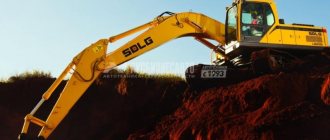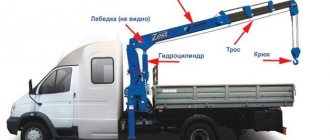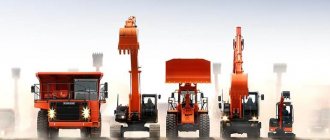Sweepers form the basis of road technical support for public utilities. The vehicle fleet of such organizations necessarily contains models for working with household waste, sediment and other types of pollution. The machines differ in operating technical parameters, operational capabilities and degree of autonomy in terms of further handling of the collected material. The basis of this segment is made up of sweeping machines, which include trailed, vacuum and other equipment.
Main characteristics of harvesting machines
Domestic vehicles serving public utilities are usually based on KamAZ, MAZ and ZIL chassis platforms. However, the active spread of foreign models often relegates this aspect of choice to the background. More significant are the parameters of the working parts of harvesting equipment, which directly affect the efficiency of the process. In the classic version, such machines are equipped with water tanks, bins for waste removal and brushes. Water tanks can have a capacity of 1000-2000 liters, depending on the power of the same chassis and the requirements for supporting work operations. As for waste bins, combined cleaning machines are equipped with containers of 6-8 m3. At the same time, not every sweeping equipment, in principle, provides for the possibility of installing such units. Brush functional organs are presented in different modifications and configurations. A typical equipment scheme involves the use of rear brushes, the length of which is about 2 m. The width can vary from 0.5 to 1 m.
Rear loading garbage trucks
This type of special equipment is more technologically advanced and convenient, however, and as a result, more expensive and demanding to maintain. These vehicles are often purchased by public utilities in large cities - despite their price, they cope excellently with a wide variety of tasks, and thanks to their high compression ratio they are able to transport more cargo, which allows the fleet to reduce the number of vehicles used.
Advantages:
- Adaptation to different containers and types of work;
- There is virtually no litter scattering;
- Safety – there are no moving parts outside the car;
- Automatic mode and manual loading option.
Flaws:
- Cost and price of service;
- Models with a high level of compaction, as a rule, are produced abroad and cost two to three times more than their Russian counterparts.
An important fact is that Belarusian/Russian-made chassis are better suited for dirt roads than Western competitors.
GeesinkNorba GPM IV
Cost: 15,500,321 rub.
As is clear from the title of the section, the loading mechanism of these vehicles is located at the rear of the body. Such garbage trucks can often be found in Russia in almost all public utilities. However, if we talk about a specific model, the Dutch company GeesinkNorba has been the leader for a long time. Their models have very different focus and functionality, but the most popular solution with a good price/quality ratio is GPM IV. Among the features of the superstructure, reliability and the ability to work in difficult conditions for a long time stand out.
It is worth noting that the garbage truck has a fairly advanced design based on unique technologies. Thus, the pressing mechanism is capable of producing an incredibly high compaction coefficient, which reaches 7. Also, an important innovation of the company in the placement of waste - most analogues press waste, resting it on the upper part of the body, which contributes to the rapid wear of the main parts. GeesinkNorba engineers went further in this matter and created a system that is capable of distributing waste evenly throughout the entire body, thereby not only protecting parts of the machine from premature wear and prolonging its service life, but also increasing the useful volume of the tank. This also includes the possibility of loading bulky waste - the width of the loading opening is equal to the width of the entire body, so no problems with large items in urban use should arise.
The bodies themselves are available in various variations - from 12 to 28 m3, but regardless of size, they are made of Hardox and Domex steel, which has excellent qualities and allows long-term operation under heavy load.
Also, this model is often used to transport large objects to recycling sites or waste transfer stations. By the way, the machine’s lifting device is multifunctional and has a lifting capacity of up to 1 ton, which allows it to work with the vast majority of containers used in Russia. Another interesting feature of GeesinkNorba GPM IV is the provision for manual lowering of the hatch roof with a lower beam when loading large bags of waste.
Taking into account the fact that the production of electric cars is actively developing in the world, GeesinkNorba is already developing cars with equipment installed on a chassis equipped with an electric motor.
Advantages:
- Easy to use;
- Many variations and models;
- High compaction coefficient;
- Uniform distribution of waste;
- Possibility of loading bulky waste;
- Strong and durable Hardox and Domex steel;
- High load capacity;
- Load capacity of the manipulator.
Flaws:
- Price;
Main technical characteristics: standard chassis MAN TGM 19.250, body capacity - 21 m3, fuel - diesel, compaction 7:1, load capacity of the manipulator up to 800 kg.
KO-440V new
Cost: 4,752,000 rub.
Domestic manufacturers also have good models in stock, and one of them is the KO-440V new produced by the Arzamas Municipal Engineering Plant. As can be seen from the prefix “new”, this is a modified version of the popular garbage truck, which received an enlarged body by 3 m3, as well as a higher compaction coefficient (it is possible to manually adjust the pressure created by the press plate). The tank volume allows you to easily load 100 European standard tanks of 1.1 m3 each.
One of the advantages is the hydraulic cylinders located on the side walls. This solution helps to extend the service life and also significantly simplifies the repair process.
The body is made of an all-metal plate, has spherical sidewalls (reinforced with a bent profile) that act as stiffeners, thereby increasing the strength and durability of the body. By the way, all these innovations are present for a reason - the body is really designed for heavy loads. An interesting feature is also the reinforced bottom of the loading bucket (its thickness is 8mm). If the buyer wishes, the plant produces a bucket from durable steel grade HARDOX 400.
The pressing process has also been redesigned, resulting in a complete cycle time reduced to 25 seconds. Another advantage is the complete unloading of waste from the bucket - there are no residues left in it. The presence of a slide valve for the drainage system from the bucket will also be very useful, which greatly simplifies work in low temperature conditions. A clear advantage that cannot be ignored is the high ground clearance. And although it was initially developed to improve cross-country ability at landfills, even on ordinary roads in some CIS countries this factor will be a significant advantage.
Interestingly, the standard kit includes an “apron” - a device that makes it impossible for waste particles to spill during unloading. As an additional option, you can purchase a tank weighing system that can recognize tanks by number. It is possible to order and install a portal grab (with it you can load large-sized waste up to 3 tons).
Advantages:
- Ease of maintenance and repair;
- Good body strength;
- Reinforced loading bucket;
- Possibility to order models made of strong and durable steel HARDOX 400;
- Drainage from the bucket;
- Large ground clearance (good for dirt roads and landfills);
- "Apron" included;
- Availability of additional options.
Flaws:
- Pressing time;
- The price is higher than that of domestic competitors (although if we consider it as an inexpensive analogue of GeesinkNorba GPM IV, then the purchase seems justified).
Main technical characteristics: standard KamAZ-53605 chassis, body capacity - 19 m3, fuel - diesel, compaction from 2.5 to 7, load capacity: waste up to 7275 kg, manipulator up to 800 kg, portal gripper up to 3000 kg.
Farid T1
Cost: upon request on the official website (based on many factors).
This is another “foreigner” who has taken root well in post-Soviet realities. The main advantage of the Italian garbage truck, in addition to reliability, is, of course, that it is heavy-duty, which means it is capable of not only transporting significant volumes of waste, but also high-quality compaction, transportation and unloading (independently, this process is completely mechanized) without loss of contents. It is noteworthy that in addition to automatic loading, FARID Industrie SpA is also designed for manual collection of solid waste, which significantly expands the range of capabilities of this machine.
The body of the “Italian” is framed, made of pipes with a square cross-section. Inside, the tank is made in the form of a steel sphere, the material of which is resistant to deformation and destruction. Thanks to the use of solid steel sheets, the walls have good rigidity and also correctly distribute the load. By the way, the shape of the tank facilitates the complete release of liquids, which prevents rust and corrosion.
The hydraulic cylinders, like those of the domestic KO-440V new, are located outside the body and, at the same time, are additionally protected by folding panels. The system itself compacts two plates moving along guides. But automatic unloading occurs thanks to a curved plate, characterized by high strength and a shape that helps remove all impurities. It is also worth noting that the tilting for garbage cans is equipped with both a Euro grip and a comb grip, and complies with the DIN standard.
The standard variation of FARID Industrie SpA works with containers with a volume of no more than 1.1 m3, however, upon request, the company manufactures and installs a portal loader up to 8 m3.
Advantages:
- Full automation;
- Heavy duty;
- Possibility of manual loading;
- The body is strong, durable and resistant to deformation;
- Liquid drainage system;
- Uniform load distribution;
- Hydraulic cylinders are located and additionally protected;
- Wide range of possibilities;
- Compaction 6:1.
Flaws:
- Price;
- Difficulties with repairs.
Main technical characteristics: standard KAMAZ, MAZ chassis, body capacity - 19 m3, fuel - diesel, compaction 6:1.
Hidro-Mak
Cost: 6,114,242 rubles (prices vary greatly depending on the chassis and additional options).
But this is a truly advanced machine, capable of not only transporting garbage and having a built-in system for washing garbage cans. It seems like something complicated, but this model is already present on Russian roads and has gained some popularity.
The washing unit itself is located in the rear of the body and consists of a pair of nozzles, the rotation of which can be controlled and the pressure adjusted within 80-100 bar. The garbage truck bin itself has a volume of 19 m3. And immediately behind the driver’s cabin there is a 1900 liter clean water tank. On average, washing one tank uses up to 20 liters of water. With an average pump output of 45–66 l/min, you can wash about 2–4 containers per minute (15 to 30 seconds per tank). It is noteworthy that all dirty water is collected in a special tank of a slightly smaller volume (1400 m3). Interestingly, the package includes a gun for manual washing, which allows you to clean the car itself or the area where the trash cans are located, if necessary.
However, convenience comes at a literal price - additional tanks cost money, they are quite heavy, and the systems require fuel consumption to operate. Also, it is definitely worth considering that in many regions of Russia, operating the machine will be difficult in the cold season. However, for an additional fee, the manufacturer equips cars with a water heating system, so it all comes down to finances. Another unpleasant moment in the operation of such installations is noise - it is unlikely that residents of nearby houses will appreciate the really loud sound of the washing system at 6 am. However, as was written above, the machine is not widespread in the post-Soviet space, but has already gained a certain popularity as a universal utility vehicle.
Advantages:
- Universal machine;
- Quality and reliability;
- A huge number of additional options;
- Washing installation;
- Possibility of manual washing;
- Good level of compaction;
- Inexpensive and practical KAMAZ chassis.
Flaws:
- Price;
- Work during the cold season may be limited;
- Noise;
- Low prevalence in the CIS countries.
Main technical characteristics: standard KAMAZ chassis, Mitsubishi Fuso, body capacity - 18 m3, fuel - diesel, compaction 6:1. The manufacturer offers a large number of modifications that radically change both the characteristics and price of the machine.
Trailed harvesters
This class represents non-self-propelled towed equipment, which has one or two wheel axles and operates in conjunction with a dump truck. Such harvesting machines also include an individual power unit, which can be a gasoline or diesel engine. The towbar is fixed to the towbar components of the main vehicle. Also, cleaning machines of this type include a special belt that sweeps debris into the dump truck container, as well as a brush system. Some versions of trailed vehicles have greater autonomy, having their own bunker units, which, however, are also aggregated with the driving machine. The disadvantages of trailed vehicles include their massiveness, wide turning angle and high fuel consumption. Especially when coupled with a tractor or dump truck, the operation of such means is quite expensive. On the other hand, high efficiency of the harvesting process is ensured.
Sweeping equipment
This is the most popular type of municipal cleaning equipment designed for work on roads. In basic configurations, such machines are equipped with a water tank, a waste hopper and a brush system. The water container can be about 1 m3, and the garbage container has a capacity of up to 2 m3 - these are indicators of typical modifications. As for brushes, the maximum length of this organ is about 3 m. Interesting developments have recently been proposed by the Elevatormelmash municipal equipment plant. In particular, cleaning machines of the Magistral series have become widespread. In one shift, such models are capable of servicing up to 52 km of street road. Such high performance indicators are due to the use of a powerful diesel engine, the power potential of which is about 60 kW.
Specifics and capabilities of the technology
As a representative of a separate caste of specialized equipment, a garbage truck stands out from vehicles for the municipal sector not only by the specifics of its use, but also by its design and equipment features. The units are integrated on the basis of a truck chassis, where the superstructure is a spacious container-type body with a variable loading method.
And a mandatory addition for automatic loading of waste into a bin is a manipulator with a special grip for standard and Euro containers or a loading plate. Such machines are capable of working with solid waste of hazard classes 1-5, guaranteeing the safety and tightness of waste transported in bulk, in bulk or in specialized containers.
Vacuum cleaners
In addition to brushes and watering machines, manufacturers produce vacuum models of road cleaning equipment. The need to use such modifications is due to the fact that traditional sweeping units collect garbage, but do not rid streets and areas of dust. Moreover, they scatter dust throughout the surrounding area, which worsens the environmental situation. Watering equipment also cannot cope with this problem; although it removes dust from roads, it clogs sewers with liquid mud. In turn, the vacuum cleaning machine sucks up dust without clogging the communications with it. The operating principle of such models is reminiscent of a construction vacuum cleaner, only with higher power. The working bodies collect dust and debris into the same bunker and deliver it to recycling points. The air flow during the suction process averages 6000-9000 m3/h.
Snow blower
Equipment for snow removal is represented by a separate category of seasonal machines. It is immediately important to divide this segment into two types - full-fledged vehicles and equipment with one axle, which is not self-propelled. Despite the advantages of machines equipped with snow collection bins, in most cases their functionality and high productivity are unnecessary. In addition, the massiveness and low maneuverability of such machines do not allow them to be used in tight streets, especially during periods of heavy rainfall. Therefore, as an alternative, a two-wheeled snow blower can be considered, the design of which is based on blades, auger mechanisms and an ejection device. The width of the snowplow varies from 30 to 80 cm, and the throw range is about 1-1.5 m. It is also advisable to use such models when cleaning small areas near entrances and sidewalks.
Garbage business and its components
After the legislative implementation of the garbage reform, the rights to collect and dispose of solid waste and solid waste were farmed out to regional players. Due to this, on the one hand, the work schemes gained some transparency, and on the other, they exposed the problem of the lack of appropriate vehicles. Operators have been waiting for the promised subsidies from the state apparatus for three years already; That’s exactly how much time has passed since the garbage industry announced the thinning and technical failure of its fleet. In the new conditions, it is no longer possible to work the old fashioned way, with ordinary trucks: the volume of waste is growing with an arithmetic progression, and the requirements of environmental standards for special equipment are becoming stricter.
Universal cleaning machine
This is the most complex transport equipment, which provides a wide range of functional equipment. Basic tasks performed by such machines include sweeping, watering and garbage collection. Moreover, each of the listed functions is performed not as an optional or auxiliary, but in a full-fledged format. For example, for sweeping, one model can use several brushes at once, including rear and front units. In addition, universal sweepers can be equipped with both standard garbage and snow brushes. Watering equipment is represented by pumping units and means for washing, which allows for combined cleaning. Also, depending on the modification, universal equipment can be provided by front and middle blades with serrated knives and sand distributors.
Information and analytical publication TECHNOmagazine
Garbage collection equipment (garbage trucks) is designed for loading, compaction, transportation and unloading at the disposal site of household and construction waste. Today, this market segment offers a wide range of domestic and imported municipal equipment.
Models differ in the base chassis, the method of loading and unloading waste, the weight of transported waste and the coefficient of its compaction in the body. The main types of garbage trucks are: side-loading body trucks, rear-loading trucks, dump trucks, bunker trucks, container and portal garbage collection vehicles. Garbage trucks with side loading are designed for loading solid waste and other waste, for its subsequent compaction and mechanized unloading at recycling sites or landfills.
The special equipment includes: subframe, body, push plate, hydraulic manipulator, hydraulic and electrical systems. Waste is loaded into the vehicle body from a container using a side manipulator, after which it is compacted by a push plate. Garbage is also unloaded using a push plate with the body raised.
Side-loading garbage trucks are classified according to the type of base chassis - low-tonnage, medium-tonnage and large-tonnage. Low-tonnage garbage trucks are most often installed on the GAZ-3307
or
GAZ-3309
. These small-sized mobile vehicles are designed for the removal of solid household waste from small residential areas. In addition, the compact size of such garbage trucks allows access to hard-to-reach waste loading areas in urban areas with dense residential areas and narrow roads. The average capacity of the body of such a vehicle is 5-8 m3, the mass of transported garbage is 2000-3300 kg.
Medium-tonnage garbage trucks are installed on more “weighty” chassis - ZIL-433362, ZIL-432932, ZIL-494560, Amur-53131, KAMAZ-4308, MAZ-4370, MAZ-4380, etc. They are used for the removal of both household and and bulky waste (including construction waste). The body of these machines is spacious - from 8 to 11 m3, it can transport from 4150 to 5500 kg of waste. Good maneuverability of the “medium-tonnage truck” is ensured by a two-axle chassis, allowing it to work in cramped conditions - in densely built areas, public recreation areas, parks, exhibition complexes, etc.
Large-tonnage garbage trucks are installed on the chassis of MAZ, KAMAZ, Ural, etc. This equipment is designed for removing large amounts of garbage. Depending on the chassis model and load capacity, the machines can transport from 5,700 to 12,500 kg of waste with a volume of 16 to 24 m3.
Foreign side-loading garbage trucks are less represented on the Russian market than domestic ones. Machines of this kind are produced by the German company FAUN Kirchoff Gruppe
(Sidepress and Twinpress models), etc. “Foreigners” can most often be seen in the fleets of public utility services in large cities. Unlike imported ones, in domestic garbage trucks the hatch of the receiving hopper is located on the side, and not on the top; in addition, the hydraulic manipulator grip allows you to load containers with a volume of up to 1.2 m3.
Like their side-loading “brothers,” rear-loading garbage collection vehicles are designed for collecting and transporting solid waste and other debris. They are divided into two classes. The first class includes garbage trucks with manual loading of garbage into a bucket, followed by mechanized loading into the body. The second class mainly includes heavy-duty garbage trucks that, using hydraulic tilters, load waste from special containers and bunkers. The tailgate of such machines consists of a receiving hopper and a pressing mechanism. Mechanically, waste is loaded through the bulk edge into a receiving hopper, after which it is compacted and pushed into the body by a pressing mechanism. The garbage is unloaded after opening the rear side of the machine using a push-out plate.
A separate type of garbage trucks are dump trucks-bunker trucks, used for transporting standard bunkers (BN-3U, etc.) with solid household or industrial waste, for transportation and dump unloading of large-sized and bulk cargo. Such garbage trucks are equipped with a frame, a hopper container, a portal, outriggers, hydraulic, electrical and pneumatic systems. Using the portal, the driver-operator removes the bin container from the frame and places it on a flat surface at the waste collection site. The container is loaded manually or with a forklift, after which it is installed on the car frame using a portal. Garbage is unloaded using a dump truck.
Another type of garbage trucks is container and straddle carriers. They can be used to mechanically load containers with solid waste and industrial waste located in residential areas or at waste transfer stations. The versatility of this machine lies in the fact that it can simultaneously transport up to three containers.
The main feature of garbage trucks, regardless of type, is their ability to lift a tank (container). The garbage is unloaded in just a minute, and then the empty tank is put back in place. The volume of the vehicle body is from 6 to 20 m3, the load capacity is from 2 to 10 tons. An important indicator of the efficiency of garbage trucks is the compaction coefficient. It is calculated for machines with a garbage compaction function and ranges from 2.5 to 6 units. Note that the highest compaction coefficient is typical for garbage trucks on heavy-duty chassis.
The following are most often used as chassis for waste collection equipment in Russia: domestic ones - KamAZ, Ural, ZIL, MAZ, GAZ; foreign - Scania, Mercedes Benz, Renault, Volvo, Ford, MAN, Iveco, etc. Two- and three-axle chassis are most in demand. Among the companies involved in the production of garbage collection vehicles are Spetstrans (St. Petersburg), BMZ (Balahna), Kommash (Mtsensk), Ekomtekh/RARZ (Ryazhsk), Plamya (Perm), Kommash "(Arzamas), LLC "Berts" (Ryazan). Installation and sale of waste collection equipment from the world's leading manufacturers (JOAB, NORBA, NTM, CosEco) is carried out (St. Petersburg): machines with rear, side or front loading, multi-chamber, with hydraulic manipulators.
— The traditional technology for the collection, transportation and disposal of solid waste in Russia has remained without fundamental changes for many years: these are standard metal containers of 0.75 m3, placed on container sites or in access garbage chutes of multi-storey residential areas, which can only be released by the side manipulators of garbage trucks, - says Tatyana Komissarova, TC Kommash LLC (Arzamas, Nizhny Novgorod region). - With the advent of plastic and galvanized Euro containers on wheels with lids, a waste collection system using rear mechanized loading was developed in many large industrial cities. This has attracted many foreign manufacturers to the Russian market from Germany (Faun, Zoeller), Finland (NTM), Sweden (Norba), Italy (Farid, Mazzocchia), Japan, the USA (Heil, McNeilus) and other countries that have long been producing garbage trucks with rear mechanized loading for containers with a volume of 0.12 to 1.1 m³.
There are several common methods of collecting household waste in Russia. The most promising is the use of Eurocontainers. Housing and communal services in Moscow, St. Petersburg, Rostov-on-Don, Tyumen and a number of other large cities have almost completely switched to this technology, which we borrowed from Europe. Note that Euro containers are quite spacious - their volume according to EN 840-3 is standardized at 660, 770, 1000, 1100 liters.
To service Euro containers, rear-loading garbage trucks are used - both on domestic (MAZ, KAMAZ, etc.) and on foreign chassis (Iveco, Volvo, Scania, etc.). Another way to collect household waste is in standard metal containers with a volume of 0.75 m3. This technology, used back in Soviet times, is still the most common. For example, almost 9,000 standard containers (0.75 m3) and about 400 Euro containers (the number of the latter is growing every year!) are installed on the streets and courtyards of Yekaterinburg. To collect waste from standard containers, side-loading garbage trucks are used, most often on a domestic chassis.
Another way to collect household waste is to use large-volume removable bins (from 7 m3 or more). In this case, the garbage is removed by bunker trucks, mainly made in Russia. According to some experts, this technology is ineffective. Its use is only advisable when it is not possible to install a sufficient number of conventional containers and remove them regularly. It should be said that containerization of solid waste does not always pay off. For example, in low-density buildings (cottages), it is allowed to take out garbage packed in bags to the side of the road - leaving it directly in bags or in individual containers (small containers, in Europe - standardized according to DIN 30740 for a capacity of 80, 120, 140 l) . These bags are then manually loaded into the receptacle of a rear-loading garbage truck. Problems may arise when removing household waste from hard-to-reach sites (dense development), to which access is geographically limited. For these jobs, it is recommended to use garbage trucks with a certain type of loading.
“So, a car with side loading requires a lot of free space to pour the contents of the container into the body, while a car with rear loading requires much less of this space,” says Evgeny Ustyantsev, director of the EMUP “Spetsavtobaza” (Ekaterinburg). Moreover, all types of Euro containers are equipped with wheels. If the entrance to the site is blocked, the loader can easily roll the container to the garbage truck and back. The coefficient of compaction of waste in the body also depends on the type of loading. Consequently, the amount of waste that a garbage truck can remove in one trip depends on this. In a removable container, the garbage is not compressed at all. It turns out that the car is carrying not so much garbage as the heavy metal container itself and the “empty space” in it. The compaction coefficient of a side-loading machine is from 2 to 2.5. The compaction ratio of a rear-loading machine is more than 5. In addition, a side-loading machine and a bunker truck can only work with one type of container. The rear loading machine picks up all types of Euro containers.
However, side-loading vehicles are still the most common type of garbage truck in Russia. According to the observations of experts, within this segment the distribution of shares between small-tonnage, medium-tonnage and large-tonnage equipment is approximately the same, with a slight advantage in favor of the latter. The trend of increasing sales of large-capacity garbage trucks on the KamAZ chassis remains relevant.
Despite the active penetration of foreign equipment into our market in recent years, the basis of the Russian municipal vehicle fleet is still made up of domestically produced vehicles. Their main competitive advantage is their affordable price. If a new domestic garbage truck can be bought for 1-1.5 million rubles, then an imported one costs two or even three times more. In addition, it should be taken into account that garbage trucks on domestic chassis are, as a rule, serial models that are always in stock, while imported equipment is often made to order. It is also important how developed the network of service stations is. Foreign equipment cannot be repaired in the garage of a motor transport company, both due to the lack of necessary spare parts and the necessary special qualifications of the mechanic.
An important competitive advantage of foreign garbage trucks lies in their quality, reliability and efficiency: the main equipment components are made of high-quality steel, electronic control systems for working bodies are used, sensors are provided to monitor the operation of the garbage truck, and comfortable conditions are created for the driver and operator. It is important that during the operation of imported garbage trucks, time and money are saved: larger container size, no loader, the driver can collect containers without leaving the cab.
“An imported garbage truck with a body volume of 12 cubic meters takes out about 70 cubic meters of waste per trip,” explains Sergei Antonov, director of Ecosystem LLC (Ekaterinburg). “A Russian car with a body of a similar volume takes out no more than 30 cubic meters. In an effort to make the cost of foreign garbage trucks more affordable, Russian manufacturers independently carry out large-scale assembly of imported equipment and install it on the chassis. According to them, the price of the machine becomes 1.5-2 times cheaper while maintaining the performance and quality characteristics. In addition, in an effort to save money, utility companies often prefer not to buy new equipment, but to partially replace the waste collection system and equipment. The most universal one installed on garbage trucks is the multi-lift system, which has a fairly simple design. A multi-lift is nothing more than a loading and unloading mechanism that is driven by a hydraulic drive. It performs the necessary functions with a cable hook grip. On garbage trucks, this system is usually mounted on a reinforced subframe. Increasingly, modern garbage trucks are equipped with lift-dumper and front-loader systems, which are also designed to simplify unloading and loading operations.
Timely garbage removal is a problem faced by the population of most cities both abroad and in our country. Among the main trends in the development of the garbage truck market in terms of the development of new models and modernization of equipment, it is worth noting Euro-containers and rear-loading vehicles, the transition to a EURO-5 chassis, the introduction of hybrid technologies, a wide range of sizes of special equipment (from a gazelle to a large truck), Reliable hydraulic equipment capable of lifting any type of container.
A new direction in the waste collection and disposal system, which came to us from Finland, is the use of buried underground containers. They are loaded into the garbage truck using a crane located behind the driver's cab. The first garbage trucks with CMU, which began to be used in Russia, were made abroad. Let's pay attention to front-loading machines, into which solid waste is loaded using a tilter that lowers in front of the driver's cabin. The idea of their creation arose in an attempt to combine the advantages of a transport garbage truck and a loader. This technique has been widely used in Europe and America since the late 1980s. But it is still little known to domestic utility services (with the exception of Moscow). One reason for this is the size of the stationary containers (5 m3) used with front-loading machines. It is important that such heavy-duty garbage trucks (with a capacity of 26-30 m3) require special sites with an entrance convenient for front loading.
A similar situation exists with machines for separate waste collection, which are widespread in European countries. In Russia, utility services are not yet ready for their mass implementation. One way or another, domestic and foreign manufacturers of municipal equipment today offer garbage trucks of different models. The choice of the required modification of the machine depends on several factors - the amount and volume of waste, the type of waste (household or construction), as well as on the territorial features of the area in which the equipment will work. Today, public utilities rely on modern, well-equipped garbage trucks, the equipment of which allows not only to speed up unloading and loading operations, but also to use different types of containers, reduce fuel costs (by reducing the number of trips), and ensure complete waste collection and cleanliness of the site.
Author: TECHNOmagazine
Share
Garbage trucks
Not every technique that directly removes waste also collects it. But even if the same sweeping machines are equipped with waste bins, they are not capable of transporting large volumes of collected material. Specially equipped garbage trucks are designed for this task. This equipment is based on trucks, which are complemented by spacious bins for loading, subsequent compaction and transportation of waste. Depending on the model, this type of cleaning machine can hold up to 3.5 tons of waste. In terms of dimensions, acceptance capabilities vary from 20 to 50 m3. In this case, the loading itself can be carried out either manually or using special mechanisms - from the rear of the machine or from the side.
Summing up
Today, big changes are taking place in the municipal equipment market - old, clattering and inefficient garbage trucks are gradually being replaced by brand new models with a huge list of capabilities. However, despite all the efforts of engineers, the trends of recent years have remained unchanged - side-loading garbage trucks are gradually being sent to landfills, losing out to rear-loading vehicles. Yes, as long as they have one significant advantage - cost. However, versatility, convenience, efficiency and safety (it is worth highlighting separately, because when loaded from the side, the mechanisms rise to a height of up to 3 meters, while the rear ones rarely exceed the bar of 1.5 meters) are forcing more and more utilities to abandon proven models in favor of new products.
In addition, the rear loading scheme involves manual loading, which is sometimes simply necessary, and also has greater compaction capacity. And in the long term, purchasing such a machine is beneficial - it holds more garbage, which means it is able to transport cargo in fewer times, which allows you to save on fuel, and even on the number of cars. However, today the choice of utility vehicles is so large that it is quite possible to choose a car to suit any needs, from inexpensive and easy-to-maintain domestic models to expensive global technological giants.











